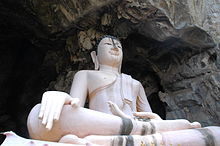Erawan cave
Coordinates: 17 ° 20 ′ 43 ″ N , 102 ° 1 ′ 9 ″ E
The Erawan Cave ( Thai : ถ้ำ เอราวัณ , Tham Erawan ) on the western border of the Amphoe Na Wang of the Nongbua Lamphu province in northeastern Thailand can be reached quite easily from the provincial capital as well as from Udon Thani or Loei . The cave used to be a popular Buddhist pilgrimage destination , but that popularity has declined significantly in recent years. With the construction of a new visitor center one wants to try to make the place a little more attractive again.
Landscape image
Rugged limestone peaks of up to several hundred meters in altitude rise abruptly from a landscape that is basically flat, which is very sparsely populated and predominantly characterized by agriculture. It is no coincidence that the forested rocks are reminiscent of the limestone islands in the Bay of Phang Nga in southern Thailand or in the Vietnamese Halong Bay - they are here, in the continental interior of Indochina , but also typical of the mountainous region of Dong Phaya Yen in the Loei region . What is a self-contained mountain region a little further north, drops here in a south-easterly direction with only a few limestone rocks into the flat plateau of the Isan .
The rock with the Erawan Cave and the cave entrance about halfway up the summit - guarded by a monumental seated Buddha figure - can already be seen from afar in this landscape. The hilltop may look like a kneeling elephant , and the side with the cave entrance like the forehead of an elephant - perhaps one reason why the naming of the cave pays homage to the mythological elephant Erawan . The cave is also called Tham Chang (in Thai: ถ้ำ ช้าง , elephant cave) by the locals .
Interior
Via a serpentine staircase with 600 steps - at the foot of the stairs there is a (modern) figure of the three-headed elephant - one reaches the cave entrance, in which there is a monumental seated Buddha figure. A stalactite cave of enormous dimensions opens up behind it : In addition to the main room, there are also numerous niches, and many of the stalagmites are given mythological names - according to their appearance or what has been indicated in them. Another elephant wants to be recognized in a limestone formation in the middle of the great hall. The bottom of the cave tends to drop further and further, and at the rear, deepest end of the cave, a chimney pointing upwards lets daylight into it again. The cave exit at the back can be reached via a steep staircase with about 200 steps; From the small pulpit in this mountain flank opposite the cave entrance, which slopes very steeply here, you have a good view of the landscape.
The cave is sparsely lit and the electric lights occasionally fail, so candles have to be used. Local boys earn a little tip by leading visitors through the cave and pointing out the names of the limestone formations inside.


